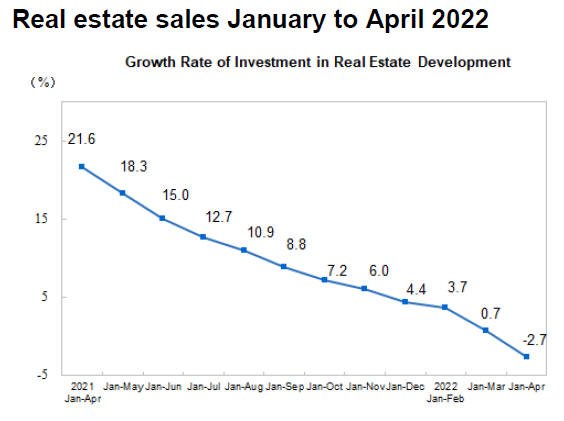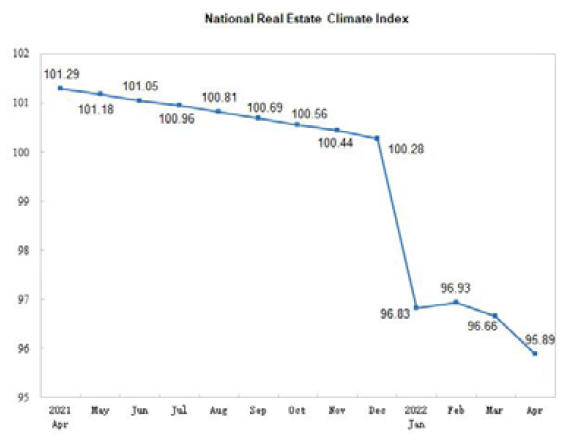US Dollar Exchange Rates of
25th
May
2022
China Yuan 6.6928
Report from China
Housing sector slump continues
A press release from the National Bureau of Statistics
provides data on housing sector developments between
January and April this year.
Total investment in real estate development in the four
months to April 2022 declined 2.7% year on year while
residential investment dropped 2.1%. The construction
area of new homes was down 26% and the area of
completed housing was down 11.9%.

National Real Estate Climate Index
In April this year the real estate development climate
index was 96 and has been falling since December 2021.

See:
http://www.stats.gov.cn/english/PressRelease/202205/t20220517_1857527.html
Assistance for real estate developers
China's financial regulators have instructed the country's
state-owned asset management companies and local banks
to extend assistance to real estate developers that are in
financial trouble.
The sectors liquidity situation has deteriorated with many
companies struggling to refinance debt and pay creditors
as home sales fall and investment slows. Efforts to
stabilise the crisis-hit sector are critical as this sector
accounts for around a quarter of GDP and consumption of
wood products in housing is at the core of the
development of the timber industries.
In the past two months the government has introduced a
variety of measures to restore stability in a sector hit by
defaults on offshore debt obligations, credit rating
downgrades and share sales.
A surge of covid infections began in April which disrupted
trade and production. Although there was a slight recovery
in May demand for wood products for construction
remains weak. A notice was recently released jointly by
the People's Bank of China and China Banking Insurance
Regulatory Commission outlining plans for assistance.
It has been stated that the covid epidemic is under control
in Shanghai and production is expanding. The pace of
resumption in more than a dozen regions in China has
reportedly reached 70-90%.
See:
http://www.cbirc.gov.cn/cn/view/pages/ItemDetail.html?docId=1051459&itemId=915
and
https://asia.nikkei.com/Spotlight/Caixin/Chinese-banks-and-baddebt-managers-urged-to-rescue-real-estate
Debut of faced plywood from automatic production
line
The first production of faced plywood has rolled off and
automatic continuous production line marking a success
for plywood mills in Linyi City, Shandong Province. This
paves the way for the transformation of the Linyi wood
industry in production of high-quality products to
international standards.
As the largest plywood production and export base Linyi
City has more than 3,300 plywood production enterprises
with an annual output of 36 million cubic metres,
accounting for 60% of the provincial total.
At present, the "automatic continuous production line of
one-step faced plywood" has successfully completed the
batch trial production and can be formally put into
operation in May 2022.
It is reported that one production line can produce 20,000
standard plywood panels per day (equivalent to the
capacity of 20 traditional enterprises).
The number of workers has been reduced from 1,500 to 70
and the mill area has been reduced from more than 13
hectares to 7 hectares. The new mill can produce 300,000
cubic metres of faced plywood annually.
Overstocking at Taicang Port
At present, the covid control measures in Taicang City
remain strict and timber transport is limited which has
created storage headache for Taicang Port. It is reported
that timber stocks have risen to about 1.7 million cubic
metres, a record high. Shanghai and Taicang areas of the
Yangtze River Delta have been heavily affected by the
current covid outbreak and are still not fully open.
As of mid May around 8,000 containers have been moved
out from the port but more than 1,000 containers of North
American timber are still stranded. It has been reported
that timber is not allowed to be unloaded at Taicang Port
and is being directed to other regional ports such as
Qingdao and then barged back along the Yangtze River.
¡®Intelligent¡¯ production of bamboo particleboard
It has been reported that a company in the Daling
industrial zone, Shaoguan City has produced 200,000
cubic metres of bamboo particleboard using an
¡®intelligent¡¯production line.
It is estimated that the annual utilisation of bamboo and
bamboo residues will reach 260,000 tonnes creating an
output value of more than RMB300 million and expanding
employment.
Sterilising wood panels the "new vogue"
Consumers have high expectations for safe products used
in the home and are no longer satisfied only with the
concept of environment-friendly and no formaldehyde.
The current trend is to antibacterial and sterilised products,
the new standard for the wood panel in the industry.
Products now marketed have antibacterial and mold
treatment such as the photocatalyst antibacterial ecological
panel, natural bean fragrance antibacterial ecological panel
and zinc antibacterial panel. Some enterprises add chitin,
nano-silicon titanium self-cleaning agent and zinc and
other active ingredients on the decorative surface of wood
panel to form a protective cover claiming this blocks
bacteria.
Household consumption has quietly changed during the
epidemic. The preference for antibacterial products has
also prompted manufacturers to step up research and
development, even though the market share for
antibacterial products in China remains small.
For home building materials enterprises such a trend
means new business opportunities.
|